Solar PV system explained: Everything you need to know
Did you know that the energy the Earth receives from the sun in just 1 hour could power the entire world for a year? Yet, many people are still hesitant about adopting solar PV systems for their homes or businesses. If you’ve ever wondered whether solar power is worth the investment, you’re not alone.
The truth is, with rising electricity costs and increasing environmental concerns, more and more people are looking for sustainable energy solutions. However, understanding how solar PV systems work and whether they’re right for you can be overwhelming. Are you unsure about the benefits, installation process, or potential savings?
You’re in the right place.
With solar energy and Solar PV systems, there’s truly a great deal of information to take in, but there’s no need to worry.
That’s because, on this page, you’ll learn:
- What a Solar PV System is and why does it matter?
- The different types of photovoltaic systems available
- How does a Solar PV System work?
- The essential components that make up a Solar PV System
- The many benefits and advantages of going solar
- The costs that come with Solar PV Systems in the UK
- Additional factors to think about when choosing the best suppliers for solar PV Systems in the UK
- FAQ
- Final thoughts
Whether you’re a homeowner looking to cut costs on your energy bills or maybe a business owner looking at ways to be more sustainable, this guide will give you a clear understanding of whether solar PV systems are the right solution for your energy needs.
Let’s get started!
What is a solar PV system?
A Solar PV System, short for Photovoltaic System, is a renewable energy solution. It captures sunlight using photovoltaic cells and then converts it into electricity.
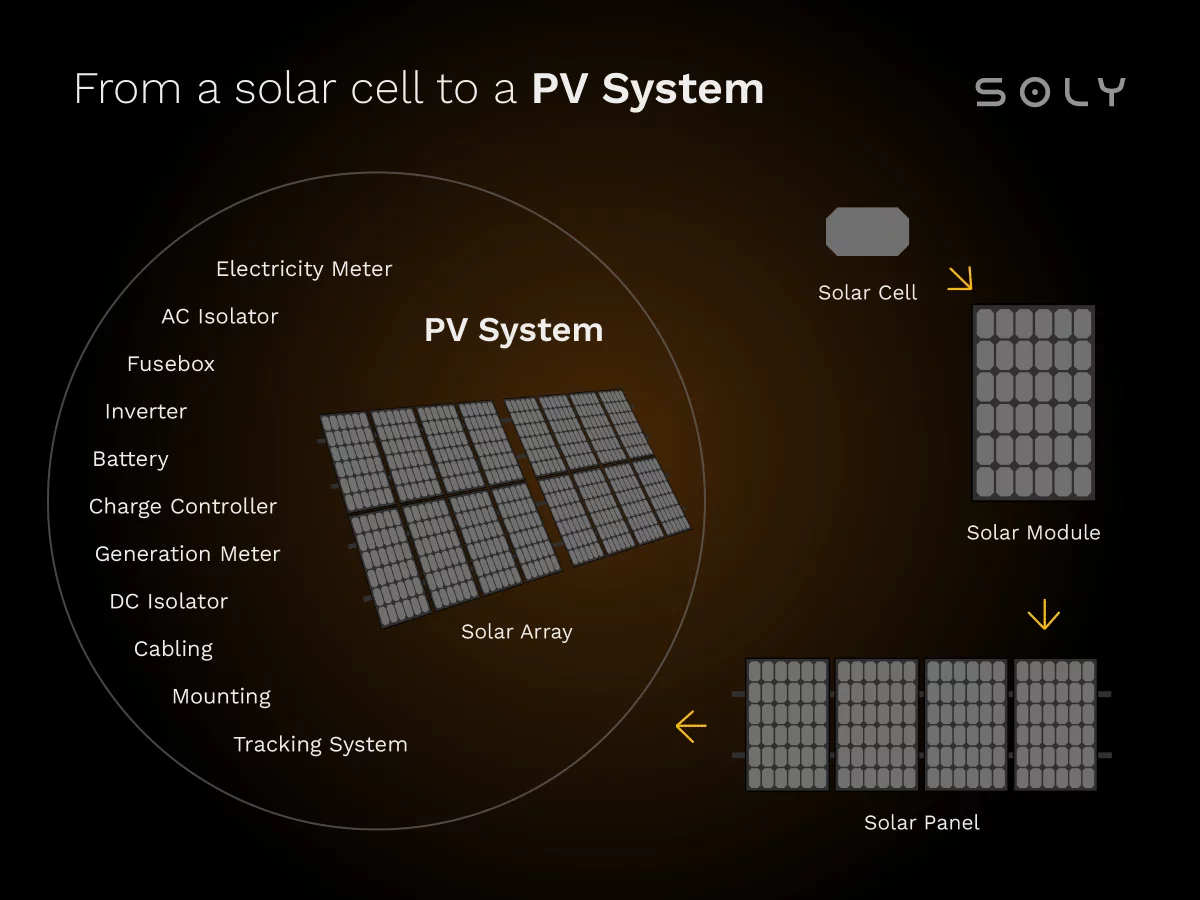
The core technology behind these systems is the photovoltaic effect. This is a process that begins when sunlight hits a solar panel that’s typically made from semiconductor materials like silicon. This sunlight energises the materials, generating direct current (DC) electricity. After that, a solar inverter converts this DC electricity into alternating current (AC) electricity (the type you use to power your home or business).
At the very heart of this green energy movement are the Solar PV Systems.
They provide a sustainable way to reduce reliance on fossil fuels and cut down on electricity costs. As efficiency continues to increase with Solar PV systems, the cost of solar technology continues to become much more affordable, making these a much more practical option for both residential and commercial energy needs.
Types of solar PV systems
Each type of system is designed to meet specific energy needs and settings. The main types include:
- Grid-Tied Systems: These are connected directly to the local utility grid. You can use solar power during the day and tap into the grid when solar production is low, often with the added benefit of net metering programs.
- Off-Grid Systems: Completely independent from the utility grid, these systems rely solely on solar panels and solar battery storage, making them ideal for remote locations without grid access.
- Hybrid Systems: A mix of grid-tied and off-grid systems, hybrids store excess solar energy in batteries but can also draw from the grid when necessary—giving you the best of both worlds.
- Community Solar Systems: These are shared solar power systems where multiple households or businesses invest in or subscribe to a single solar installation, sharing the electricity it generates.
How does a solar photovoltaic system work?
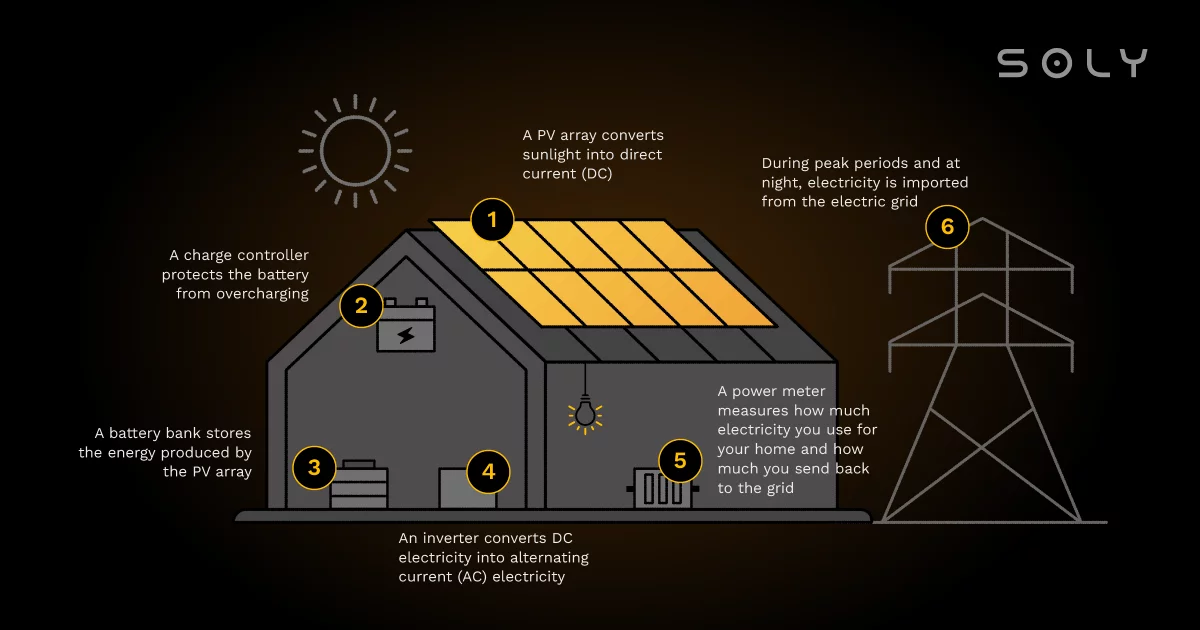
At the core of each and every solar PV system is the ability to turn sunlight into solar electricity. This is a fascinating process that’s rooted in the photovoltaic effect. Below, we’ll provide a breakdown of how it all works:
- Solar Panel Activation: When sunlight strikes the solar panels, which contain photovoltaic (PV) cells, these cells absorb the sunlight’s energy. Each PV cell is made from semiconductor materials such as silicon. These react to sunlight and create an electric field.
- Generation of Direct Current (DC) Electricity: The absorbed energy causes electrons in the PV cells to move and creates an electric current. This current is direct current (DC), meaning it flows in one direction.
- Inversion to Alternating Current (AC): Since most homes and businesses use alternating current (AC) electricity, the DC electricity generated by the panels is sent through an inverter. This converts it into AC and makes it ready to use for everyday appliances.
- Distribution and Use: The converted AC electricity is then distributed throughout your home or business. Through this conversion, you’re powering everything from lights to appliances. If you have a grid-tied system, then any excess solar electricity can be fed right back into the grid. This could possibly earn you credits or lower your utility bill through net metering.
- Energy Storage (Optional): In systems with battery storage, any extra energy not immediately used can be stored for later use. This means you can have power even during the night or on cloudy days. At Soly, we offer three types of lithium-ion batteries: Enphase, GiveEnergy, and Fox. All three are low voltage and come with a 15-year warranty. To become more self-reliant and environmentally conscious, we recommend combining solar panels with battery storage.
- Grid Interaction (For Grid-Tied Systems): In a grid-tied setup, if your solar panels aren’t producing enough electricity to meet your needs, your system automatically draws electricity from the grid. Likewise, if you’re producing far more than you’re using, you can send that surplus solar electricity back to the power grid.
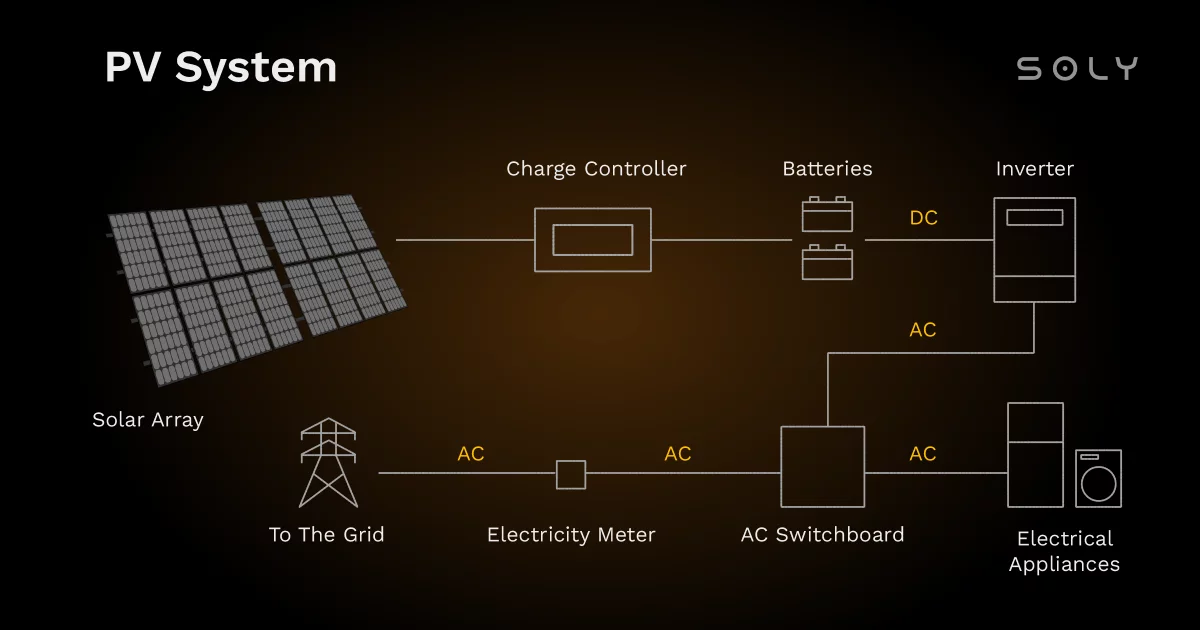
The flawless integration of solar power into your daily life is what makes Solar Power PV Systems such a smart and completely efficient solution for renewable energy. It reduces your carbon footprint while offering you substantial savings on your energy bills.
Solar PV system components
Investing in a solar system means getting more than just panels on a roof. You get a collection of key components that work together to convert sunlight into usable electricity. In this section, we’ll break down each part along with its role within the system:
1. Solar panels
Think of the photovoltaic panels as the stars of the show. They are responsible for capturing the sunlight and are made up of photovoltaic (PV) cells. These are usually made from silicon and the panels generate direct current (DC) electricity through the photovoltaic effect.
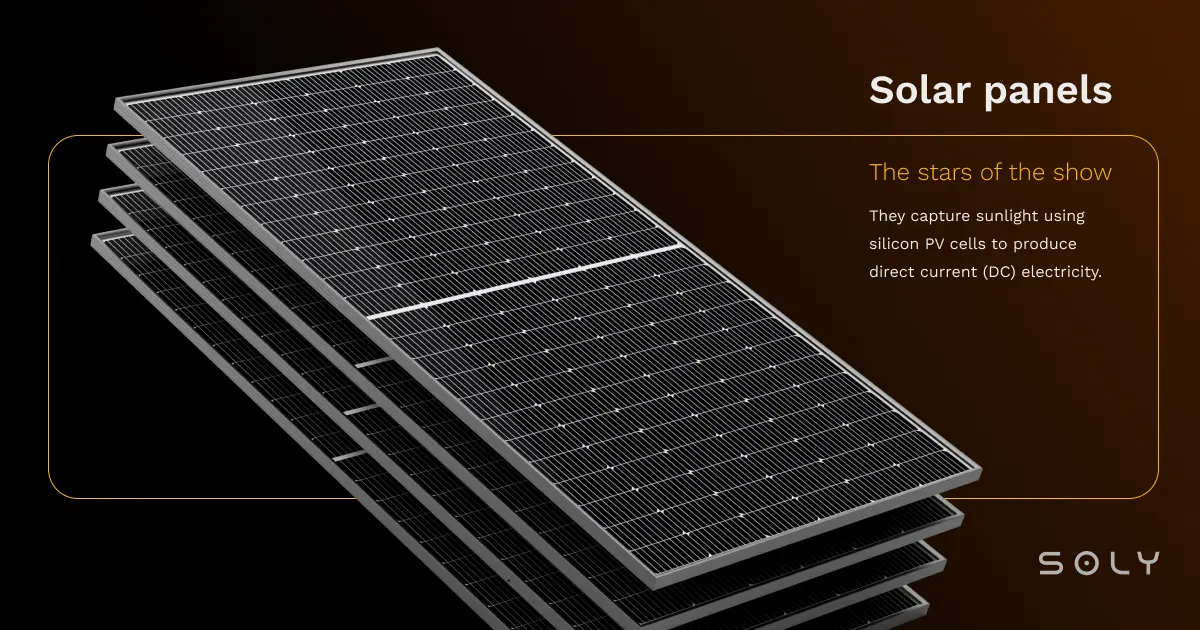
Types of solar panels:
There are three main types of solar panels:
- Monocrystalline solar panels: As solar panels go, these are known for their high solar panel efficiency and sleek look. Monocrystalline panels are made up of a single crystal structure and offer efficiency rates above 20%. When space is limited, these are the most ideal. However, they come with a higher price tag.
- Polycrystalline solar panels: These solar panels are made of multiple silicon crystals that have been melted together. These panels can be slightly less efficient, at around 15-18%, but are more budget-friendly. Their bluish hue and speckled appearance make them easily recognisable and a popular choice amongst consumers.
- Thin-Film solar panels: As the least efficient of all solar panels at 10-13%, the thin-film panels are also the most flexible and lightweight. This makes them a great option for the more unique applications, such as curved surfaces or portable setups. Thin-film panels are also much more affordable but require more space to generate the same amount of energy that you’d get from the crystalline panels.
2. Inverter
Think of the solar inverter as the workhorse of the PV system. It converts the DC electricity produced by the panels into AC electricity which is what your home or business uses each and every day. Without an inverter, the electricity produced by the panels wouldn’t be usable for most applications.
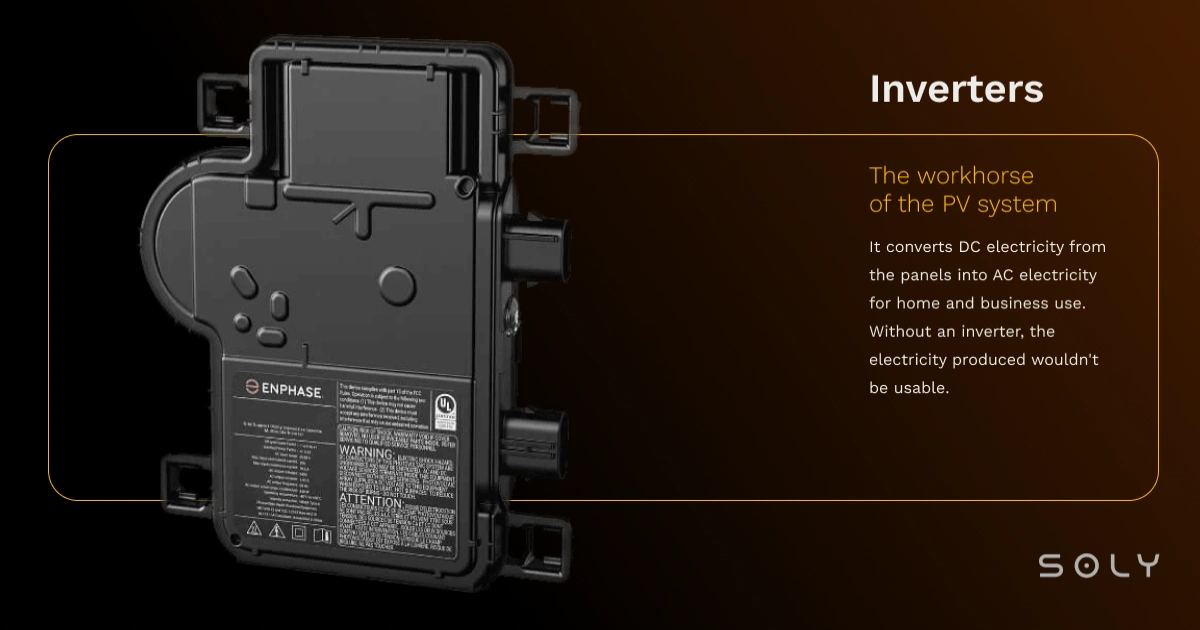
Types of inverters:
There are several types of inverters and choosing the right inverter for your solar panel system is going to help you make the most of your investment. At Soly, we want to help you understand what options are available so you make the right choice for your home or business. Here’s the rundown:
- String inverters: This is the most common type. String inverters connect a series of solar panels to a single inverter (forming a string). This makes them cost-effective and simple to install. It’s a popular choice for residential installations. However, their performance can be affected by things like shade.
- Microinverters: These little powerhouses are installed on each individual solar panel. They convert DC to AC power right at the panel. This means each panel will operate independently. At Soly, we offer Enphase microinverters. We have two types, one for parallel-connected systems and one for serial-connected systems. With Enphase microinverters, you get a 25-year product guarantee from an inverter that you can count on along with your solar panels. This is because microinverters typically lead to higher overall system efficiency.
Keep on reading:
Difference between serial and parallel connection of solar modules - Power optimisers: Power optimisers offer a smart middle ground. Like microinverters, they manage the output of each panel individually. However, instead of converting DC to AC at the panel, they optimise the DC output before sending it to a central inverter.
3. Battery storage (optional)
While entirely optional, battery storage is becoming more popular. This is especially the case in areas with unreliable grid power. Batteries are an excellent option as they store excess electricity for later use or when solar power generation is low, so that you have power when you need it the most.
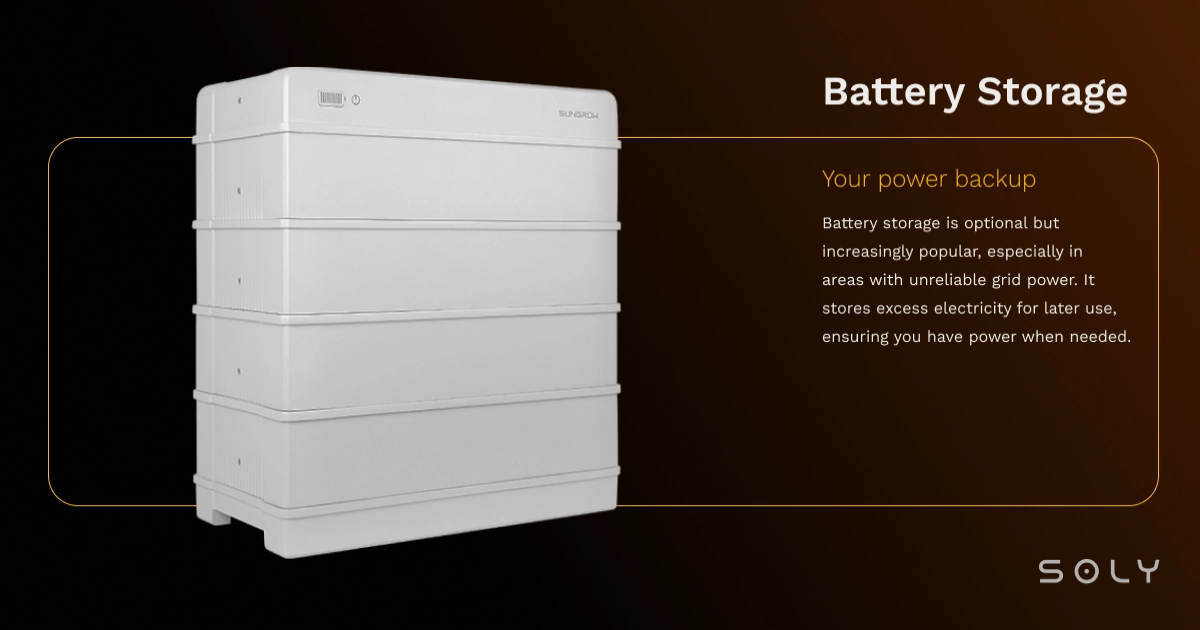
Types of home batteries:
When it comes to choosing a solar battery, we like to make it simple to understand the options available at Soly and beyond, as well as how each type can benefit your solar panel system. Here’s a breakdown of the two main types of batteries you might consider:
- Lithium-Ion Batteries: These are the gold standard in solar battery technology today. At Soly, our batteries are lithium-ion and offer high energy density which means they can store a lot of power in a compact space. They also have a longer life- and higher efficiency than older battery types. This makes them perfect for daily use. You can charge and discharge them many times without much wear and tear. This makes them a great choice if you’re looking for something you can count on that’s low-maintenance and lasts.
- Lead-Acid Batteries: Lead-acid batteries may be an older technology, but they’re still in use today. Particularly in off-grid solar systems or where keeping upfront costs low is especially important. Although these batteries are much cheaper initially, they come with more trade-offs. Lead-acid batteries have a much shorter life-, far lower efficiency, and more frequent maintenance needs. This means that these batteries are best suited for smaller systems or situations where the budget is the primary concern.
Why should you add a home battery to your system?
Integrating battery storage into a solar system provides several benefits, including increased energy independence, enhanced back-up power during outages*, and the ability to maximise self-consumption of solar energy.
At Soly, our range of batteries include Enphase, GivEnergy, and Fox, ensuring you can get the most out of your solar energy system. When you’re ready to explore solar battery storage, our options are tailored to suit different needs and budgets. Plus, with our easy solar panel finance options, going green has never been more readily accessible.
*This is only available with an EPS where the battery can be set to island mode.
4. Charge controller
Systems that have battery storage need a charge controller in order to manage the flow of electricity between the panels, batteries and inverter. This prevents overcharging, which can lead to a shorter battery life.
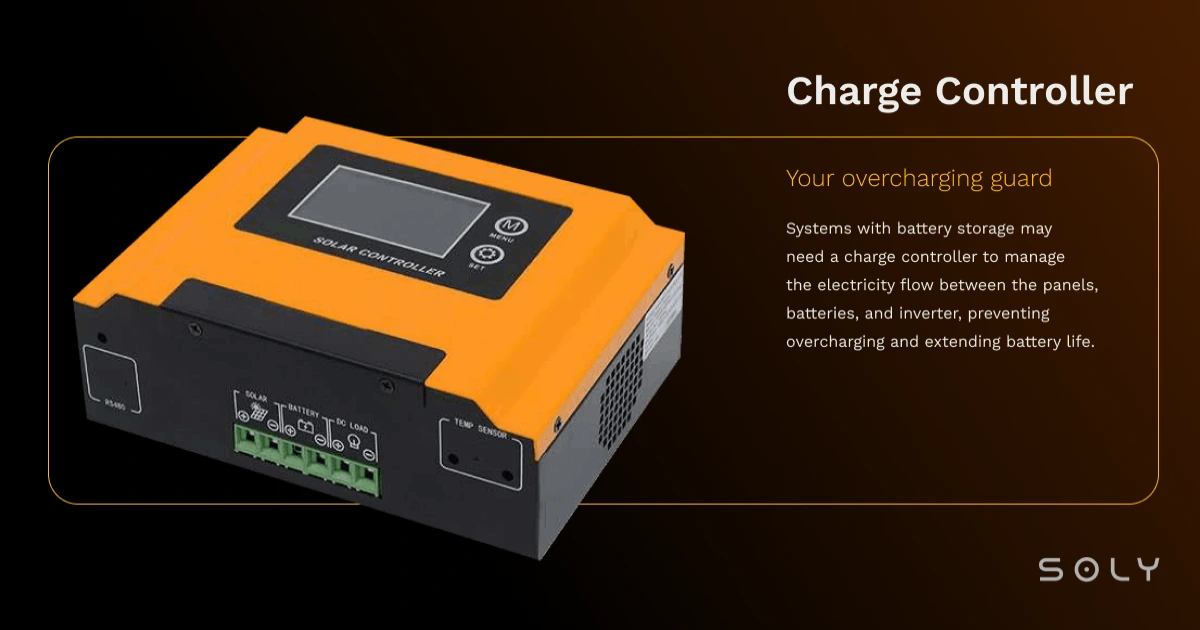
Expert Insights
We do not need system controllers in the UK, unlike in most EU countries. The only instance where we would use such controllers is for phase coupling in a 3-phase system, which is extremely rare—occurring in less than 3% of domestic homes in the UK.
Types of charge controllers:
There are two main types of charge controllers:
- Pulse Width Modulation (PWM) Controllers: PWM controllers are simple and affordable. This makes them perfect for smaller systems. They gradually reduce power sent to batteries as they get closer to full charge. This helps prevent overcharging.
- Maximum Power Point Tracking (MPPT) Controllers: More advanced and efficient, MPPT controllers ensure your panels are always operating at their maximum power point. This can increase system efficiency by up to 30%. This makes them a great choice for those that are looking to maximise their output.
5. Mounting systems
Solar mounting systems are what keep your solar panels securely in place.
So whether the panels are on your roof, ground, or even attached to poles, mounting systems make sure that the panels are at the best angle to catch the most sunlight. Additionally, they’ll withstand environmental stressors such as wind, snow, and seismic activity.
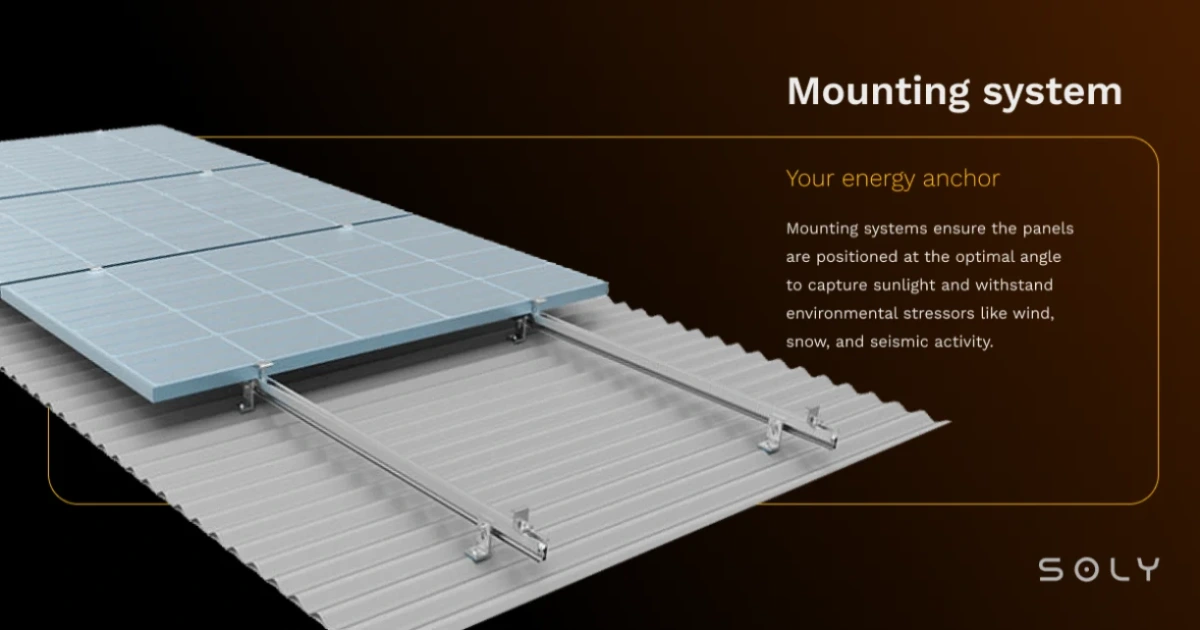
Types of mounting systems:
There are different types of mounting options and they include:
- Roof-mounted systems: This is the go-to choice for homes because they save space and are usually more cost-effective. They typically depend on the condition of your roof and the orientation of it though.
- Ground-mounted systems: Since these are installed on the ground, they offer more flexibility in panel orientation and tilt. This makes them perfect for bigger properties. Ground-mounted systems are easier to access for maintenance but generally require more space and can cost more to install.
- Pole-mounted systems: These are raised up on poles and can even track the sun’s movement. They offer top-notch performance as a complex system that is expensive, but can yield a much higher energy production.
6. Monitoring systems
If you want to keep an eye on how your solar power system is doing, you need a monitoring system. These systems keep you informed by providing real-time data on how much energy you’re producing, using and the overall health of your system.
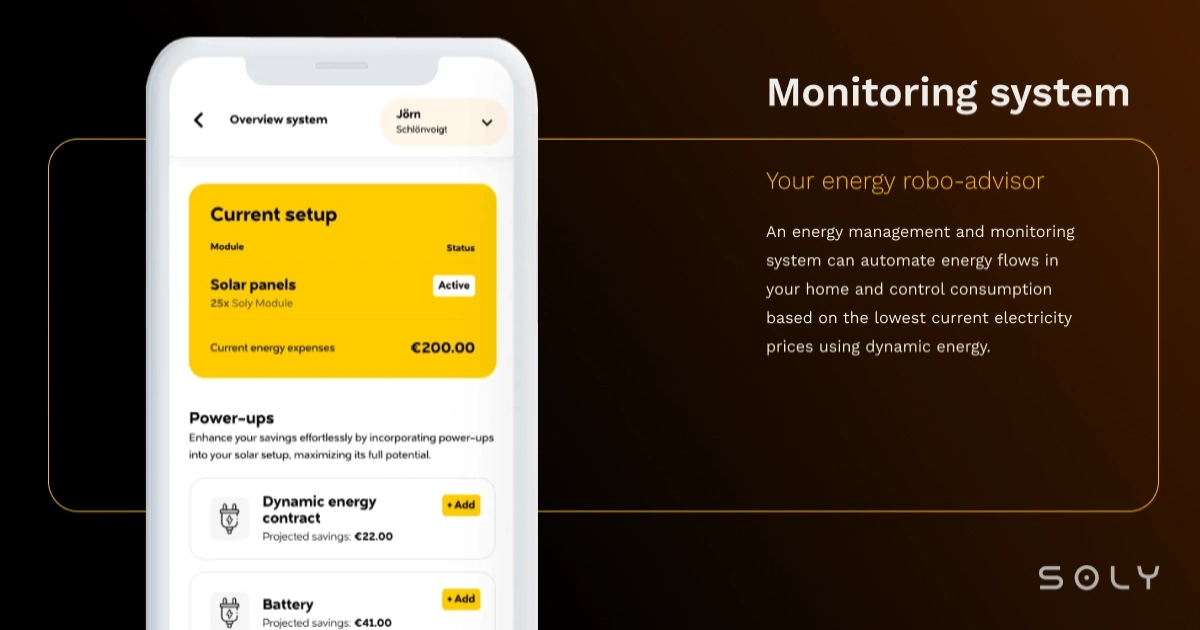
Monitoring options:
At Soly, we offer ways to track your solar systems savings in real-time. Our accredited installers also help you install monitoring apps to track system performance and we believe that this is the ideal way for users to optimise their energy usage and quickly identify any issues.
Overall, monitoring can be done through:
- Online dashboards: These are websites where you can login from any device to see how your system is doing. You can also see if it needs any maintenance.
- Mobile apps: These apps are a lot like online dashboards. With them you can easily access your system’s data through your phone. The app can even send you alerts if there’s ever any performance issues, making it easier than ever to maintain your system and maximise efficiency.
- Energy metres: Some systems include physical metres installed at the site that show basic performance data. These are ideal for those who are looking for a straightforward way to monitor their system.
When combining all of these components, it creates an incredibly powerful and efficient Solar System that’s capable of providing clean, renewable energy to your home or business. This makes understanding each of these components and their roles important, so that you can better appreciate the intricacies of solar technology and make the right decisions when purchasing your solar system.
Advantages of a solar power system
It’s always important to remember that investing in a Solar System isn’t just good for the planet, it’s also going to save you money and make your home more independent from the grid. Let’s take a closer look at some of the main benefits that come with installing a solar power system:
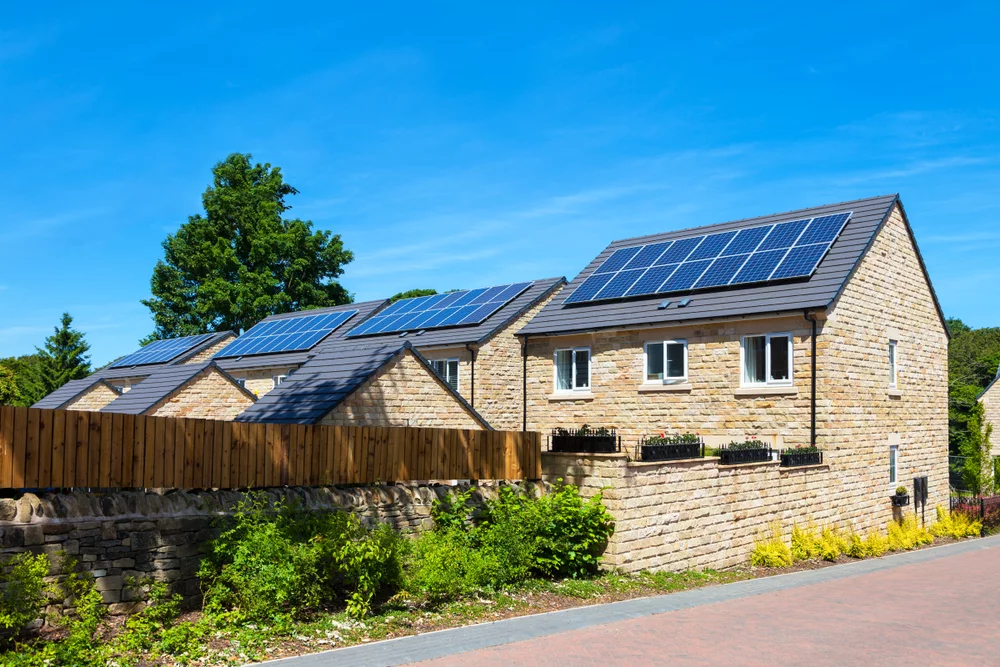
✓ Environmental Benefits:
Solar power is a clean, renewable energy source. So, think of solar power as using the sun’s energy to create electricity without the downsides, like pollution or greenhouse gases. When we harness the sun’s energy, solar PV systems produce electricity without emitting carbon dioxide (CO2) or other harmful pollutants. This helps combat climate change and reduces air pollution, benefitting public health and our environment.
Additionally, solar power doesn’t use much water, which is great for conserving this precious resource.
✓ Financial Savings:
Imagine what it could be like to drastically cut down on your electricity bills just from having solar panels on your roof. That’s one of the most compelling reasons people adopt solar power systems. It’s the potential substantial financial savings. Over time, the money you save can cover the cost of the panels and maybe more. This is advantageous in locations with high energy costs or where electricity prices are expected to rise in the future. Plus, there are even government incentives that can help reduce the initial costs, making solar power even more affordable.
✓ Increased Energy Independence:
With solar panels, you generate your own electricity. This is going to give you greater energy independence and reduce your reliance on the power grid. This can be very useful if you live in an area with frequent blackouts. When you generate your electricity from the sun, you no longer depend on the utility companies and you protect yourself from energy price volatility.
In 2024, energy prices are expected to increase by 10%, citing political tensions and extreme weather events. This comes as no surprise, and we can expect further increases in the coming years.
Regions that are more prone to power outages or where the grid is even less dependable, being energy independent is even more important. Plus, if you add a battery to your system, you can store extra energy, to ensure you always have power.
✓ Increased Property Value:
Homes with solar panels are in demand. Oftentimes, they tend to sell faster and for a higher price*. This is because buyers like the idea of lower energy bills and a smaller carbon footprint. This makes solar panels a smart investment if you’re considering selling your home.
✓ Minimal Maintenance Requirements:
Once your solar panels are installed, there’s not much upkeep required. At Soly, our systems are designed to last. Our panels for instance, come with warranties of up to 25 years. Most continue to produce electricity well beyond this period with minimal efficiency loss. Depending on the provider you choose, you may need a regular cleaning, but with Soly panels, your panels don’t need cleaning.
Keep on reading: Pros and Cons of solar panels
Solar photovoltaic system cost in the UK
The solar panel costs in the UK can vary widely based on many factors. These include the size of the system, the type of equipment you choose, and the specific needs of your solar panel installation site. Understanding these costs is important for anyone thinking about investing in solar energy.
Average cost of solar PV system components by system size (UK)
*The figures in this table are based on systems that use 455W panels.
**Small systems typically require an average of 6 solar panels, mid-sized systems about 11 panels, and large systems around 18 panels.
***Please note, all prices shown are estimated costs for UK homeowners. For a precise quote tailored to your needs, we recommend reaching out to a professional installer. Don’t worry—Soly is here to simplify the process and guide you every step of the way! The only thing you need to do is either contact us by email or phone, or use our online configurator to book a call with one of our consultants in the final step.
Average solar pv system costs
To get a better idea of what you could spend, here’s what a typical breakdown could look like:
For a typical home setup in the UK (4 kWh solar PV system with 11 solar panels at 455W each), the cost of a solar PV system in the UK ranges between £8218 and £9863 on average. This includes everything (solar panels, inverters, mounting systems, and other necessary components).
For larger or more complex installations (for a business), costs can go over £20,000.
The cost of a solar system is mainly determined by its size, which is measured in kilowatts (kW). A standard residential system typically ranges between 2 kW and 5 kW. This is usually enough to meet the energy needs of an average household. Larger systems are going to produce more electricity and will come with more upfront costs. However, they can also save you more in the long run.
Factors affecting solar pv system costs
When looking at the final cost of a solar system in the UK, there are many factors that could come into play. These include:
- System Size: Larger systems can produce more electricity but are also more expensive to purchase and install. However, they can also offer greater savings in the long run by reducing your reliance on the grid and potentially allowing you to earn money through schemes like feed-in tariffs.
- Quality of Components: The quality of the solar panels, inverters, and other components used in the system can have a significant impact on the overall final cost. High-efficiency panels and advanced inverters tend to cost more, but usually perform better and last longer.
- Installation Complexity: How complex the installation process is can also affect the final costs. For instance, installing panels on a roof with a tricky design or hard-to-reach areas may require more labour or specialised equipment, which could lead to higher costs. Even ground-mounted systems that are thought of as easier to access, might need extra infrastructure like foundations, which can also increase costs.
- Location and Orientation: The geographical location where you install the system and the direction (orientation) the panels face can affect the system’s efficiency and the cost of the system. In the UK, a south-facing orientation is perfect for getting the most sunlight. However, not all roofs can accommodate this. Considering adjustments such as tilting panels or using tracking systems can improve performance, but will also add to the total cost.
- Permits and Regulations: Depending on where you live, in some cases, you may need to pay for permits or meet regulations, which can increase your costs. For example, in England, when installing solar panels on a flat roof will require special permissions. Also, Part P of Building Regulations around electrical safety requires compliance for all solar panel installations.
Financing options for a solar photovoltaic system
What’s great about solar in the UK is that there are many solar financing options available to make it more affordable. There are many avenues available so that homeowners and businesses alike can invest in solar energy. Options for a solar photovoltaic system include:
Option #1: Solar loans:
Many banks and financial institutions offer loans specifically designed for solar installations, often with better terms and interest rates than standard personal loans. At Soly, we’re proud to be partnered with Hometree Finance to make it easier for you to switch to clean, renewable power so you can start saving on your energy bills.
Option #2: Solar leasing and Power Purchase Agreements (PPAs):
With leasing, a third party instals and maintains the solar system on your property and you pay a monthly fee to use the system. PPAs work in a similar fashion. However, instead of paying a fixed fee, you pay for the electricity generated by the system at a rate lower than the grid’s electricity price.
Option #3: Government incentives:
Although some of the more generous incentives in the UK like the Feed-in Tariff (FiT) have been phased out, there are still programs available. These include the Smart Export Guarantee (SEG), which will pay you for any excess amount of energy you have. Through this scheme, the unused energy is exported back to the grid.
Also, in the UK, solar panels and battery systems are exempt from the 20% Value-Added Tax (VAT).
Option #4: Paying out of pocket:
You can also purchase a system outright using your own money with no financing whatsoever. This requires a significant amount of money upfront, but has several advantages, including:
- No interest payments: No interest charges, reducing overall cost.
- Full ownership: You immediately own the system and benefit from all the savings, without involving a third party.
Indubitably, paying upfront can be the most cost-effective option in the long run if you can afford to put up the capital for it.
But for those who don’t, at Soly, we make the cost more easily accessible in the UK with financing options. We offer monthly payment solutions through Hometree Finance so that more UK residents can make the switch to clean energy.
Additionally, we offer Soly clients the option to make a full payment on their solar pv system after installation, with an upfront deposit of £500.
Although the investment upfront can be substantial, the long-term savings, along with environmental benefits, can make it quite worthwhile.
Key factors to consider when choosing the best suppliers for solar PV systems in the UK
Choosing the solar expert for your Solar PV System is of the utmost importance. Here’s what to look for when choosing the best:
- Product Quality: Make sure the supplier offers high-quality, efficient panels and inverters that meet your energy needs. Be on the lookout for certifications and industry standards that indicate the products are reliable. At Soly, we strive for the highest standards as a Certified B Corporation. We aim to meet the industry’s highest standards for quality and efficiency.
- Installation Experts: Select a supplier with a proven track record of successful installation. Experienced installers are vital when it comes to optimising system performance and ensuring safety. At Soly, we’re pleased to say that we only work with trusted local installers across the UK who are accredited by HIES, TrustMark, and MCS.
- Warranty and Aftercare: A robust warranty on panels, inverters, and battery storage is essential. It’s also important to consider availability and quality of aftercare services for any long-term maintenance needs of your system. When you choose Soly for Solar panels, you can enjoy up to 25-year guarantees on the panels. Our solar batteries come with 15-year guarantees.
- Customer Reviews: Always look at what other customers are saying to gauge the supplier’s reputation for service quality, reliability, and customer support. With over 35,000 happy customers and over 800,000 completed instals, it’s easy to gauge the reputation of Soly.
- Price and Value: While cost is important, it’s crucial to balance price with the quality of the products and services offered. Sometimes, paying a bit more upfront can lead to greater savings and reliability in the long run.
FAQ
What is the difference between solar system and PV system?
A solar system can include both solar thermal and photovoltaic (PV) technologies, while a PV system specifically converts sunlight into electricity using solar panels.
Is PV better than solar?
PV refers to solar electricity generation, while solar also includes heating. PV is better for generating electricity, but solar thermal is better for heating applications.
Is solar PV still a good investment?
Yes, solar PV remains a good investment due to decreasing costs, long-term energy savings, and environmental benefits.
What are the 5 components of solar PV system
Solar panels, inverter, mounting system, batteries (optional), and charge controller. You can also add a monitoring system to track overall performance of your system and how much energy you’re producing or using.
Final Thoughts
Investing in a Solar PV System requires careful planning. However, with the right information and a trusted partner like Soly, you can enjoy the long-term benefits of clean, renewable energy.
Why choose Soly?
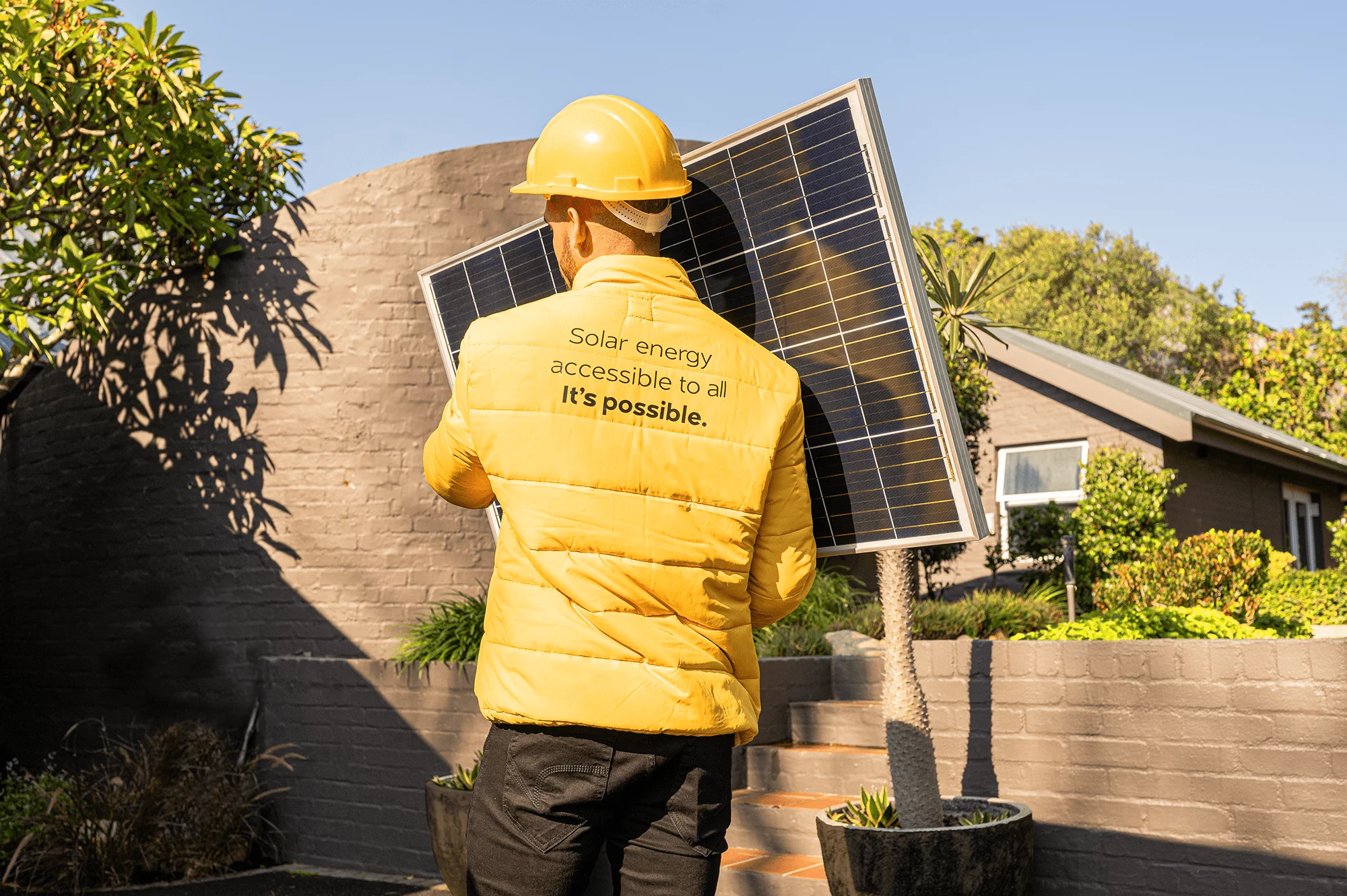
At Soly, we make solar energy simple. Here’s why we stand out:
- We’re proud to have a 4.7-star rating on TrustPilot and to be a certified Which? Trusted Trader.
- We only work with installers that are local, reliable, and accredited by HIES, TrustMark, and MCS.
- With over 10 years of experience in the solar industry and more than 35,000 happy customers, we know what it takes to deliver high quality installations.
- Our solar panels come with up to 25-year guarantees, depending on the system you choose, and our solar batteries have 15-year guarantees.
Soly: Empowering You with Solar Energy
As a leading clean energy tech company, we have a growing presence in the UK. At Soly, we’re committed to making solar energy accessible to everyone. We connect all the dots to make you as independent from the power grid as possible:
- Solar Panels: We offer solar panels with up to 25-year guarantees.
- Solar Batteries: Soly batteries are from Enphase, GivEnergy, and Fox and come with 15-year guarantees. They store self-generated power from your solar panels for later use.
At Soly we offer digital tools like our online configurator so you can calculate how many solar panels you’ll need, how much electricity you’ll generate, and just how much you can save.
Contact our solar experts today to see how we can help you with all the best components for your solar PV system.